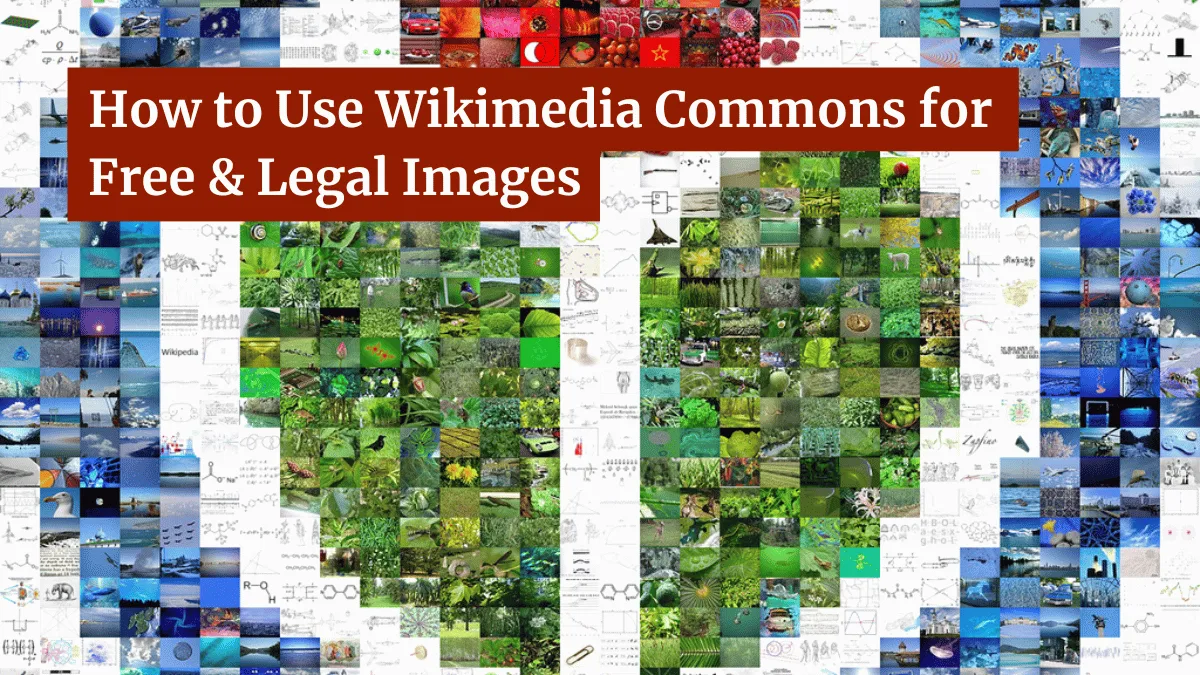How to Use Wikimedia Commons for Free & Legal Images

If you need a photo for your article, your video or other project, there is no shortage of free and low-cost stock photography websites out there. Sites like Pexels, Pixabay and Unsplash all offer free stock images that you can use with or without attribution.
However, free and low-cost stock photography collections tend to be generalist in nature. They are great if you just need a generic photo of a flower, a crowd of people or even a city. Unfortunately, they are unlikely to have photos of specific people, places, events.
For example, none of the three sites above have a recent or usable photo of Taylor Swift or King Charles (or Prince Charles). However, free and legal photos of both do exist, including ones in the public domain.
The secret is simple, when looking for a specific image, focus on Wikimedia Commons. According to their statistics, they have over 103 million files, including over 92 million images. All the images are free to use, albeit under a variety of different licenses.
As such, Wikimedia Commons is an excellent place to source certain kinds of images. However, it can be very intimidating to use, especially given the aforementioned variety of licenses.
Luckily, the process is actually remarkably simple and the site itself provides the tools that you need to make legal use of the images (and other content) contained on it.
Step 1: Visit Wikimedia Commons

While this step might seem obvious, it is an important one to follow. The reason is that many people discover Wikimedia Commons from searches on Wikipedia.
However, that has a serious problem. Though many, if not most, images on Wikipedia do come from Wikimedia Commons. Not all do. For example, if you search for The Addams Family TV series on Wikipedia, the first image is the title screen.
Though Wikipedia’s use, most likely, is fair use, the site warns that any other use of it may be copyright infringement. This is because Wikipedia routinely uses images that they do not have a license, albeit under a strict set of rules. Still, there is no license for others to use those images.
Wikimedia Commons, on the other hand, only lists images for which a license exists. This means that any image you find on that site, you can likely use on your website or other project.
Step 2: Search Wikimedia Commons

Searching Wikimedia Commons is a straightforward process. Simply type what you are looking for and go.
You can also narrow down your search using the modifiers at the top of the search page. This includes finding images that are a certain size or are marked as “Quality Images” by the community.
However, bear in mind that the “License” function may not work as anticipated, especially if you are seeking works with “no restriction.” Some images, such as this one, are considered by Wikimedia Commons in the public domain, but only in the United States. As such, searching for “no restrictions” will not turn up that image.
With Wikimedia Commons, it is often best to look for the image you want first and simply comply with the license, especially if the image is not likely to be public domain in all jurisdictions.
Step 3: Check the License of The Image

Once you have found the image that you want, click “More Details” in the text underneath the image to bring up the page for the image itself.
There, under the image, you can find out information about the license for the image. Most images in Wikimedia Commons can be found either under a Creative Commons license or in the public domain. However, there are images under other licenses including GNU Free Documentation, India’s Government Open Data License, and others.
As such, it is important to check and ensure that the license is compatible with what you want to do with it. Typically, the most it asks of you is that you provide attribution (which we will get to in a minute) and that any derivative works based on it are licensed under the same terms.
The latter point may be an issue for those seeking to use it for non-standalone purposes, which is why it is important to know both how you want to use the image and what the license says.
Step 4: Provide Attribution (If Required)

If the image requires attribution, Wikimedia Commons makes it easy to comply. Beside the image there is a link to “Use this file on the web.” From there, if you are using the image on a website, click the “HTML” tick and copy/paste the required HTML to use. If you are using it in a print application, you can simply copy the non-HTML version.
You can also copy the code to embed the file, either on a website or a forum, either of which will append the needed attribution. However, bear in mind that embedding carries risks, namely that it relies on Wikimedia Commons both continuing to offer embedding, having the image and being available itself.
In addition to the web link, you can use the “Use this file on a wiki” link if using it on a wiki page and, once again, attribution will be automatically added.
Step 5: Get the Correct Size Image

After making sure you understand and comply with the license, the next step is to get the correct version of the image for your purpose.
Though you can easily right click the image itself, the preview image is rarely the largest size available and may not be the best size for you. Instead, look underneath the image for “Other Resolutions” and choose one that most closely fits your needs.
In some cases, image sizes can get incredibly large, so it is best to find an image size that is closest to what you need. This saves time, space, and bandwidth.
Step 6: Pull it All Together
With that, all you need to do is use the image and ensure that the copied attribution (if required) is reasonably well attached to it, and you should be good to go.
To be clear, how you apply this attribution will vary based upon your specific use but, in general, the closer it is to the image and the more obvious that it applies to the image the better.
That said, the most important thing is that the attribution statement has all the required elements. Fortunately, that is something that Wikimedia Commons helps with.
Some Additional Notes
When using images (or other files) on Wikimedia Commons, it is important to sanity check the license.
While mistakes are rare, Wikimedia Commons provides no guarantee that their licensing information is accurate. As such, make sure that the licensing information makes sense and that you follow up on information in the licensing information to confirm that it is valid.
Typically, in the file information and file history, you can look at how the file was originally submitted and find out if the trail makes sense.
Second, remember that, if you want or need to use an image beyond the terms of the license, you can always ask. In most cases, the author information provided is adequate to track down the creator and contact them directly.
There is nothing stopping you from asking for permission to use the image in other ways.
Finally, remember that the whole of this post only looks at copyright. Images on Wikimedia Commons may raise other issues including trademark, publicity, privacy and so forth.
While complying with the copyright is important, it is equally important to make sure that neither the image nor your use of it violates any other rights.
Bottom Line
Wikimedia Commons is rarely my first choice when I am looking for stock images. As someone who subscribes to a stock photography service, most of my needs are met fairly well.
That said, when I come up empty from the usual sources, it is usually because I need something that is too specific and, for that purpose, Wikimedia Commons is usually my next stop.
While it can be inconvenient to use given the various licenses, the site provides good tools to make the process as easy as possible and, with just a little bit of knowledge, it is easy to find good images to use and ensure that you are complying with the license.
However, the usual caveats do still apply. As with most free stock photography websites, there is no guarantee of accuracy, and you are using the images at your own risk. Still, the community, overall, does a respectable job with accuracy and the information provided makes it easy for you to investigate the work yourself.
As such, it is a valuable resource for anyone who regularly needs to use stock images, especially for specific issues.
Header Image: see history of Wikimedia logo mosaic, CC BY-SA 3.0, via Wikimedia Commons
Want to Reuse or Republish this Content?
If you want to feature this article in your site, classroom or elsewhere, just let us know! We usually grant permission within 24 hours.
